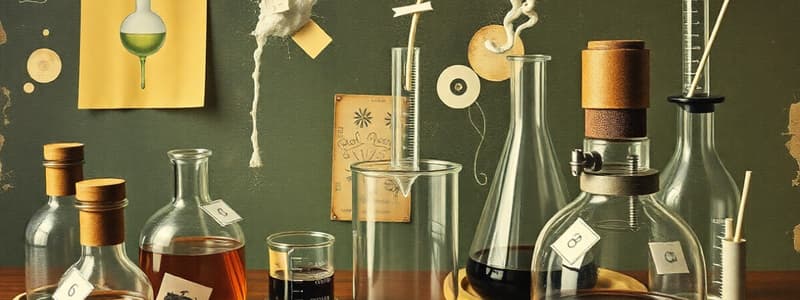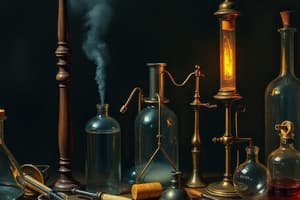Podcast
Questions and Answers
What is the primary purpose of a laboratory room?
What is the primary purpose of a laboratory room?
To provide a controlled environment for scientific research and experiments.
Identify two preventive measures to ensure safety during laboratory experiments.
Identify two preventive measures to ensure safety during laboratory experiments.
Wearing safety goggles and keeping hands away from the face.
What is the difference between prokaryotic and eukaryotic cells?
What is the difference between prokaryotic and eukaryotic cells?
Prokaryotic cells lack a membrane-bound nucleus, while eukaryotic cells have a defined nucleus.
List two items you should know the location of in the laboratory for emergency situations.
List two items you should know the location of in the laboratory for emergency situations.
Why is it suggested to wear glasses rather than contact lenses in a lab?
Why is it suggested to wear glasses rather than contact lenses in a lab?
Explain the significance of safety signs in a laboratory.
Explain the significance of safety signs in a laboratory.
What should you do if a spill occurs during an experiment?
What should you do if a spill occurs during an experiment?
What is one way to maintain cleanliness in the laboratory?
What is one way to maintain cleanliness in the laboratory?
What is the primary structural difference between prokaryotic and eukaryotic cells regarding the nucleus?
What is the primary structural difference between prokaryotic and eukaryotic cells regarding the nucleus?
How do the sizes of prokaryotic cells compare to those of eukaryotic cells?
How do the sizes of prokaryotic cells compare to those of eukaryotic cells?
What type of cell division is characteristic of prokaryotic cells?
What type of cell division is characteristic of prokaryotic cells?
Identify one main difference in ribosome size between prokaryotic and eukaryotic cells.
Identify one main difference in ribosome size between prokaryotic and eukaryotic cells.
What are the two types of cell walls found in eukaryotic cells?
What are the two types of cell walls found in eukaryotic cells?
List an example of a unicellular microorganism and a multicellular organism.
List an example of a unicellular microorganism and a multicellular organism.
What role do membrane-bound organelles play in eukaryotic cells?
What role do membrane-bound organelles play in eukaryotic cells?
What are spirochetes, and how are they classified in terms of bacterial aggregation?
What are spirochetes, and how are they classified in terms of bacterial aggregation?
Flashcards
Laboratory Room
Laboratory Room
A controlled environment for scientific research and experiments.
Preventive Measures
Preventive Measures
Safety rules to follow in the laboratory.
Safety Goggles
Safety Goggles
Protective eyewear used to shield eyes from hazards.
Prokaryotes
Prokaryotes
Signup and view all the flashcards
Eukaryotes
Eukaryotes
Signup and view all the flashcards
Clean-Up Protocol
Clean-Up Protocol
Signup and view all the flashcards
Lab Safety Signs
Lab Safety Signs
Signup and view all the flashcards
Chemical Handling
Chemical Handling
Signup and view all the flashcards
Eukaryotic Cells
Eukaryotic Cells
Signup and view all the flashcards
Prokaryotic Cells
Prokaryotic Cells
Signup and view all the flashcards
Nucleus
Nucleus
Signup and view all the flashcards
Cell Division Types
Cell Division Types
Signup and view all the flashcards
Ribosomes
Ribosomes
Signup and view all the flashcards
Organelles
Organelles
Signup and view all the flashcards
Microbiology
Microbiology
Signup and view all the flashcards
Bacterial Forms
Bacterial Forms
Signup and view all the flashcards
Study Notes
Laboratory Room
- A laboratory room is a controlled environment designed for scientific research, experiments, analysis, and measurement.
- These rooms are equipped with specialized instruments, tools, and safety equipment.
- Researchers, scientists and technicians use these labs for accurate and safe experiments.
Laboratory Instruments
- Bunsen burner is a common laboratory instrument used for heating
- Evaporating dish is used for evaporating liquids.
- Bacterial loop used in microbiology to transfer bacterial cultures.
- Wire brush for cleaning lab equipment.
- Crucible and cover are used to heat and contain substances, often in chemical reactions or analyses.
- 24-well plate used in experiments that involve multiple samples.
- Test-tube rack holds test tubes for organization and stability.
- Mortar and pestle are tools used for grinding solids.
- Wash bottle for dispensing liquids.
- Forceps are tools used for handling small items or specimens.
- Lab burner is a heating device, often used in conjunction with other lab equipment
- Pipet is used for precise measurement and transfer of liquids, typically used to measure small amounts of liquids in laboratory
- Graduated cylinder to measure and quantify volumes of liquids in laboratory settings.
- Volumetric flask used for accurate liquid measurements.
- Conical flask is used for heating, mixing, and storing liquids, typically in laboratory settings.
- Dropper allows controlled addition of small amounts of liquid, commonly used in lab.
- Watch glass provides a flat surface to evaporate solvents or other liquids, used commonly
- Funnel used for directing liquids into containers with smaller openings
- Petri dish is a shallow dish used in microbiology to cultivate microorganisms or sample substances.
Laboratory Safety
- Listen carefully to instructions before any experiment.
- Wear safety goggles to protect your eyes.
- Notify your teacher of any spills or accidents.
- After handling chemicals, wash your hands completely.
- Keep your hands away from your face during experiments.
- Tie back long hair
- Roll up long sleeves
- Know the location of emergency equipment (fire extinguisher, first-aid, eyewash station)
- Keep the area clutter free
- Do not use/wear contact lenses.
- Do not put anything in your mouth during experiments.
- Clean up your lab area.
- Do not eat or drink.
Laboratory Safety Signs
- Safety signs are standardized symbols that communicate important lab safety information.
- These signs help protect personnel and visitors from potential hazards.
- Common categories of signs: eye protection, hand protection, respiratory system protection, foot protection, head protection, hazardous substances (radioactive, toxic chemicals, flammable, oxidizers, poisonous, corrosive, reactive, compressed gas).
- Additional categories can exist for other hazards.
- "No food or drink in lab" sign is important to prevent contamination of samples.
Microbiology
- Microbiology is the study of microscopic organisms.
- This can include unicellular organisms such as bacteria, multicellular organisms like fungi and acellular organisms, like viruses.
- All living organisms can be sorted into Prokaryotes or Eukaryotes based on cell structure.
- Prokaryotic cells are simple, single-celled organisms, which lack a membrane-bound nucleus and other organelles, and typically smaller. Genetic material is in a region called the nucleoid. Bacteria is an example.
- Eukaryotic cells are complex, containing a membrane-bound nucleus and other organelles, and typically larger. Examples: Plants, animals, fungi, and protists.
- Prokaryotes are classified by shape and aggregation (cocci, bacilli, spirilla, spirochetes).
Studying That Suits You
Use AI to generate personalized quizzes and flashcards to suit your learning preferences.




